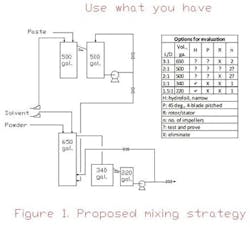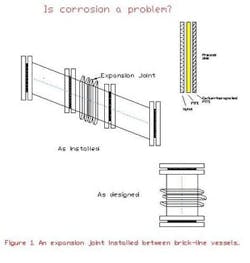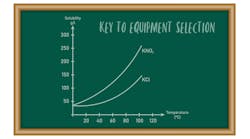THIS MONTH'S PUZZLER
We blend a partially dehydrated color paste with mineral turpentine (C9–C16 range) at a volume ratio of 15:85. The final flow is 25 gal/min. We then disperse solids, up to 20% by weight, in the solvent. The solids form clumps. The paste isn't shear sensitive. The mixture is chilled to reduce vaporization. As a result, solvent viscosity is somewhere between glue and milk after chilling. The final product is an oil-based paint that is heated before use in a sprayer. Turpentine is driven off and recycled. One engineer has proposed blending this mixture in one shot with a single hydrofoil impeller in a tank with a 1.5:1 length-to-diameter (L/D) ratio. We have baffled closed tanks available in the mix room with L/D ratios of 1:1,1.5:1, 2:1, 2:1 and 3:1 and volumes of 340 gal., 220 gal., 500 gal., 500 gal., 650 gal., respectively. Can you suggest a better way of mixing the products? How can we improve this process to make it safer, easier to operate and more environmentally friendly?
USE AN INLINE MIXER
Has an inline mixer set-up been considered? This doesn't appear to be a chemical reaction process, only a mixing process. Currently the process description indicates cooling to lower vaporization then heating. Use an inline mixer in a pipe, with the pump pressurization to reduce vaporization eliminating a heat exchange step. Feed components at various locations in the line. Design the process to allow recycling if more mixing time is needed.
Larry Stephans, retired
Rochester, N.Y.
GO ULTRASONIC
Why not try ultrasonic stimulation at various temperatures and pressures?
Tom Murphy, CEO
Puritrol, Inc., Centerville, Mass.
Organic Technologies, Coshocton, Ohio




